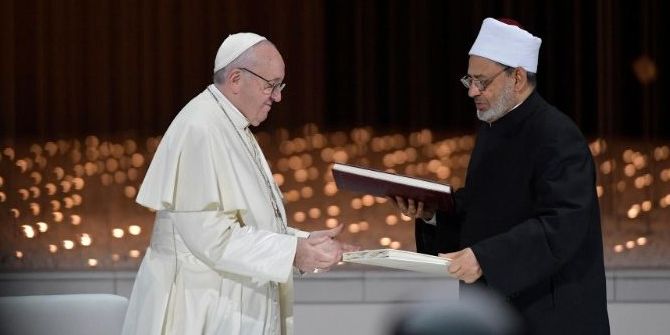Religious and cultural practices can be so deeply entrenched and normalised as to seem unremarkable, even mundane, to those who live by them. In the case of circumcision, a little boy’s reluctance to partake in this particular tradition can be seen by his elders as cute and endearing, but ultimately silly and juvenile. Reflecting on a recent case, Kai Möller challenges this comfortable reading. He suggests instead that the child was agonising over an impending violation which the adults around him would not perceive.

On 13 July, the world learned of a nameless, five-year-old Indonesian boy who was so terrified about his impending circumcision that he climbed on the roof of the hospital where the procedure was about to take place and remained there for more than two hours. Eventually, the doctors, parents, and a teacher managed to convince him to come down. He allegedly did not even struggle, cry or complain when the procedure finally took place.
There are two ways to interpret this incident. The doctor, who posted the story and a picture of the boy on the roof of the hospital on Facebook, presents it as being about a little boy who is, maybe understandably but ultimately unreasonably, scared about a minor and beneficial procedure. Fortunately, he is surrounded by his loving parents, responsible teacher and competent physician. With the help of this empathic and loving environment, the boy understands that he is in good hands and accepts and endorses the circumcision. The newspaper reader smiles, looks at the picture of the little boy on the roof, thinks – yes, children are cute, and sometimes so stubborn! I never wanted to go to the dentist, either! – and moves on to read the next story.
I want to challenge this comforting reading of the incident. Suppose for a moment that in fact the only person who behaved normally in this story was the little boy? Surely there is something very healthy in his seeing what his environment blocked out: that his body, and in particular its most intimate and private part, belonged only to himself, and that nobody – not his parents, not his doctor, not his teacher – had any business interfering with it, let alone cutting off a part of it. He also sensed that none of these people, whose roles are to protect and nurture him, had his interests in mind. They were under the spell of their religion, culture, society, and maybe, especially in the case of the males, their own unprocessed trauma. All these factors prevented them from understanding the simple and straightforward fact that it is terrible for a five-year-old boy to submit to an operation that removes a part of his penis.
The little boy not only intuitively understood all this; he was also able to respond adequately. By climbing on the roof, he protected himself and cut off the access of those people who threatened his integrity. He also communicated the severity of his anxiety by making his parents extremely anxious.
But this strong message was not heard by anyone around him. Even now, religion, culture, and trauma prevented those around him from seeing what is so glaringly obvious: this boy’s terrible fear of a mutilating act. So he is lured down, the circumcision goes ahead, and the doctor afterwards presents the story to the world as one of compassion on the part of the adults.
Which version is true? Perhaps a little bit of the first but perhaps also a large measure of the second. Healthy children like this boy protest against abuse. But they are also desperately dependent on the love and nurture of their parents and their environment without which they literally die – and they intuitively know this. A child who faces abuse by his environment eventually surrenders. Worse, he often represses the negative emotions associated with the abuse. It has to be this way because the child is dependent on his parents and has to maintain a good and, as far as possible, trusting relationship with them going forward. After the little boy’s rather extreme protest fell on deaf ears, he had no chance but to accept not only the mutilating operation but possibly also the infliction of emotional trauma that might burden him for his whole life, unless someone in his environment finally wakes up and listens to him.
Male cutting is becoming more controversial in Western societies, largely as a consequence of an increasing number of affected men speaking out publicly against the practice and more scholarship questioning its moral, legal, and medical justifications. I have recently contributed to this discussion through a scholarly article on the lack of compatibility of male cutting with the human rights of children and a blog entry. The sad story of this little boy invites us to finally look at male circumcision from a different and maybe the most important angle, namely the position of those on whom it is inflicted: babies and little boys.
Almost all public discussion of ritual circumcision is about the perceived interests of religious people and religious groups to continue the tradition of genital cutting that they perceive as necessary for their identity. It is so easy to ignore the voices of those who are the victims of such practices, namely children. This is not because they don’t communicate: the little boy in this story communicated admirably, strongly, and clearly. Rather it is because nobody listens to them. Their agony, physical and psychological, goes unheard because those around them are in the grip of forces that have led them to closing their eyes, ears, and hearts to the most obvious signs of extreme distress on the part of those who they love and who need their protection.
Note: This piece gives the views of the author, and not the position of the LSE Religion and Global Society blog, nor of the London School of Economics.






Thank you.
I hope so much some day we will understand what this trauma means for the making of maskulinity and I hope this day will come soon.
I am still optimistic.
Some yearn for human rights, others are numb. giving up is a kind of hopelessness.
Anyone who does this should be forced to hear the blood curdling agonized screams of your newborn as they strap him spread eagle to a board, then sometimes inject ineffective pain relief in the most sensitive area of the body, but often not. Then they take 2 steel forceps and clamp them down on the most nerve dense skin on your newborn and rip the membranes apart. Then they take a third forceps and create a “crush line” on this normal healthy functioning innervated tissue. Then they take a scissors and cut the crush line. Then they pinch the bleeding flaps of skin and pull them with the forceps into a clamp and apply 2500 pounds of force to crush the skin further before cutting it off with a knife while this conscious sentient human is screaming in agony. Hundreds die in the US and thousands are maimed every year for a completely unnecessary cosmetic procedure to “prevent masturbation” in babies that “don’t feel pain” and “won’t remember” and “slept right through” having 75% of their erogenous nerve endings cut off.
This happens because the boy was only 5 – he’s become cognizant of his own body, but yet to be insufficiently indoctrinated by his parents that their religion requires this.
Circumcision appears in the Old Testament (Genesis 17) but is not confirmed by the Qur’an, since it does not appear anywhere in the Qur’an.
Therefore it is clearly an addition to the Abrahamic faith, written in by the clergy of the time, and carried over into hadith of Muhammad
Circumcision is genital mutilation, plain and simple.
Your religion does not give you the right to mutilate your child’s genitals.
If your religion can’t survive without circumcision, your religion is useless.
What is sad, circumcision even inside United States behaves like a science fiction mind virus. Its done in secret and if there be scars, and there always is, it is made to look foolish. I don’t think a five year old feels nothing at his circumcision. This is the level of denial and absolute disgusting depths of sexual abuse this horrid procedure on children is. Religion is not excuse or exception.